Tri tip. It’s not just a cut of beef, it’s a cut above the rest. Unlocking its flavors to their fullest potential takes more than just a sprinkle of salt and pepper. It requires method and precision.
In this comprehensive guide, we’ll explore the ins and outs of cooking tri tip to perfection – from reverse searing on the grill, to the precision of sous vide, to the convenience of the oven.
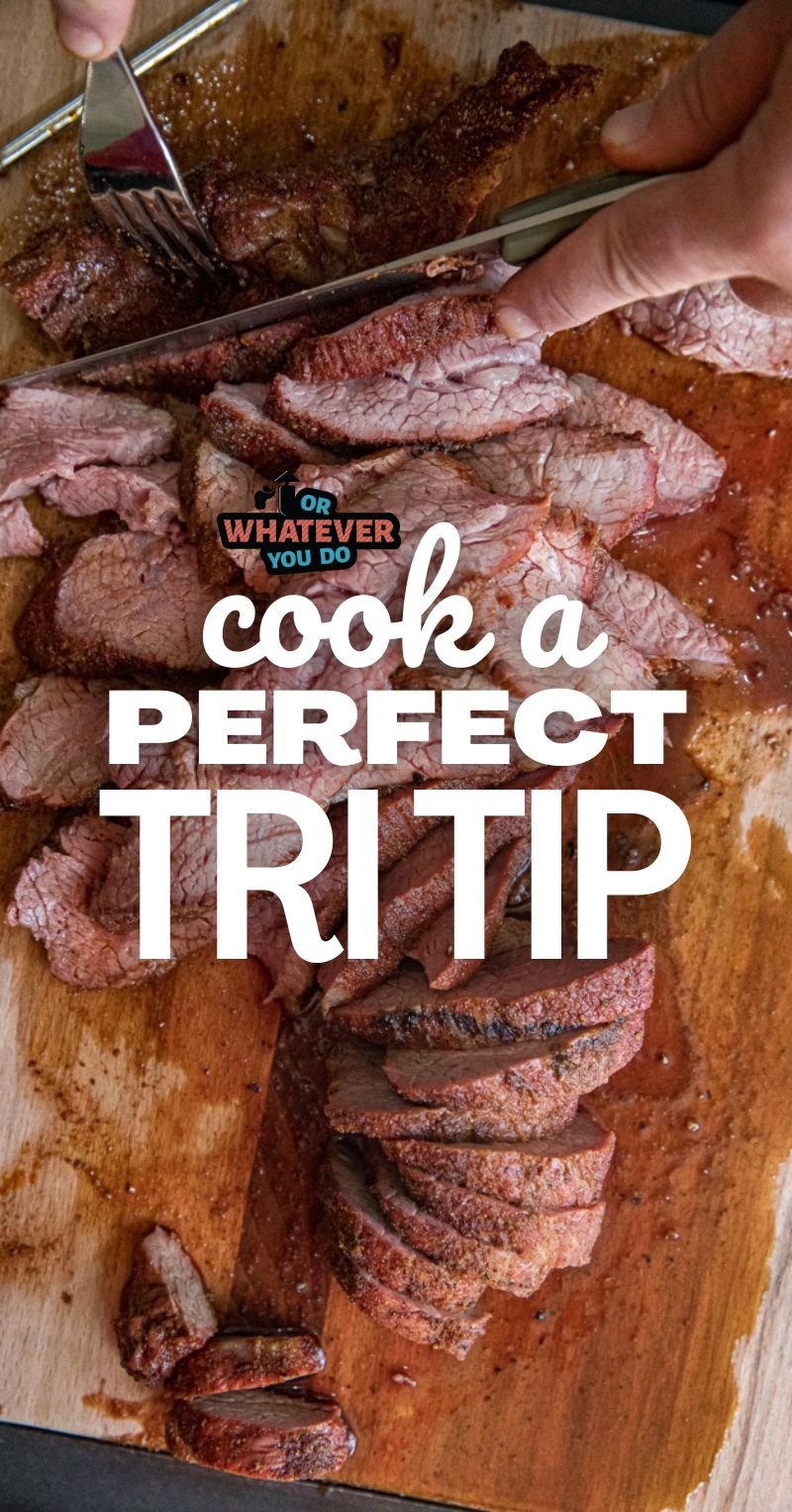
The Ultimate Guide to Cooking Tri-Tip
You may be asking, “What’s so special about tri tip?” Well, this triangular cut of beef from the lower sirloin has been a well-kept secret for a long time. Praised for its rich flavor and relatively low cost, it’s become a favorite among meat lovers. But – its unique shape and grain structure require some special attention when it comes to cooking.
We’re about to deep dive into the world of tri tip cooking, taking you step by step through different cooking methods, offering tips and tricks for achieving that perfectly tender, juicy steak. Whether you’re a seasoned grill master or an amateur chef, by the end of this you’ll be cooking tri tip like the pros.
So, are you ready to bring out the best in your tri tip? Let’s turn up the heat and get started. Remember, cooking isn’t just about following recipes. It’s about understanding the ingredients, the process, and the method. When it comes to tri tip, it’s about finding that sweet spot between the sizzle and the sear, the heat and the meat.
Try with some of our Homemade Cole Slaw!
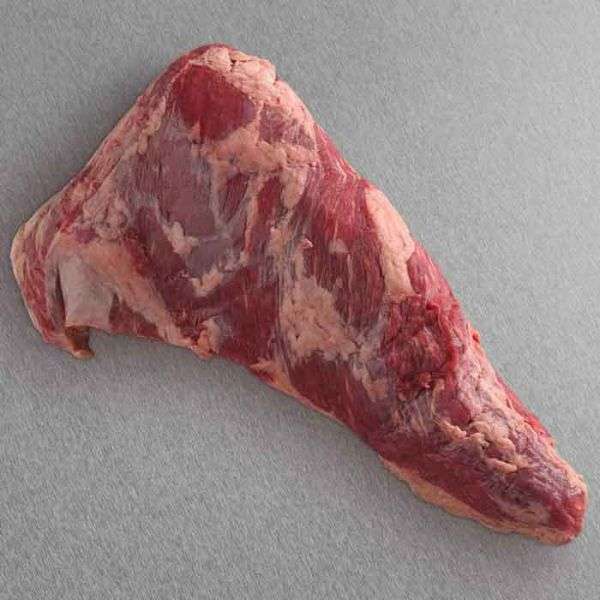
Understanding the Tri-Tip
Tri tip is a cut that really defeats people sometimes. You can’t just cook it like any old steak or roast. We’re going to break it all down for you and make it not only totally doable for you, but EASY.
What is tri tip?
Tri tip is a unique, triangular piece of meat sourced from the lower part of the sirloin. Hence the name “tri tip”. Each side of beef contains only one of these, making it a butcher’s delight.
While not as well-known as ribeye or filet mignon, tri tip has been gaining popularity for its rich flavor and tenderness. It’s especially beloved in California, where it’s often the star of barbecues, but it’s slowly winning hearts and palates across the globe.
The characteristics of a good tri tip
A quality tri tip will be robust and rich in flavor. It’ll have a beautiful, deep-red hue, indicating its freshness. An essential characteristic to look for is marbling – the thin veins of fat running through the meat. These not only add to the juiciness of the steak but also greatly enhance the flavor when cooked.
The tri tip’s unique grain pattern is another vital characteristic. It runs in two different directions, meaning it requires special attention when slicing. Cut it against the grain, and you’ll get incredibly tender slices, perfect for any method of cooking. We’ll include a whole section on cutting tri tip below, including a handy graphic to help out.
Where to buy quality tri tip
When it comes to buying tri tip, you have a few options. Supermarkets often carry it, but it might be labeled under different names, like “bottom sirloin tip” or “Santa Maria steak”. Just ask your butcher if you can’t find it.
For the best quality, consider sourcing your tri tip from a local butcher or a trusted online meat purveyor. They often stock superior quality cuts from grass-fed or organic beef. Although these options might be more expensive, the flavor payoff is considerable. Remember, your dish is only as good as the ingredients you use.
If you want to splurge, pick up a Tri Tip from Snake River Farms.
Serve with some Homemade BBQ Sauce too!
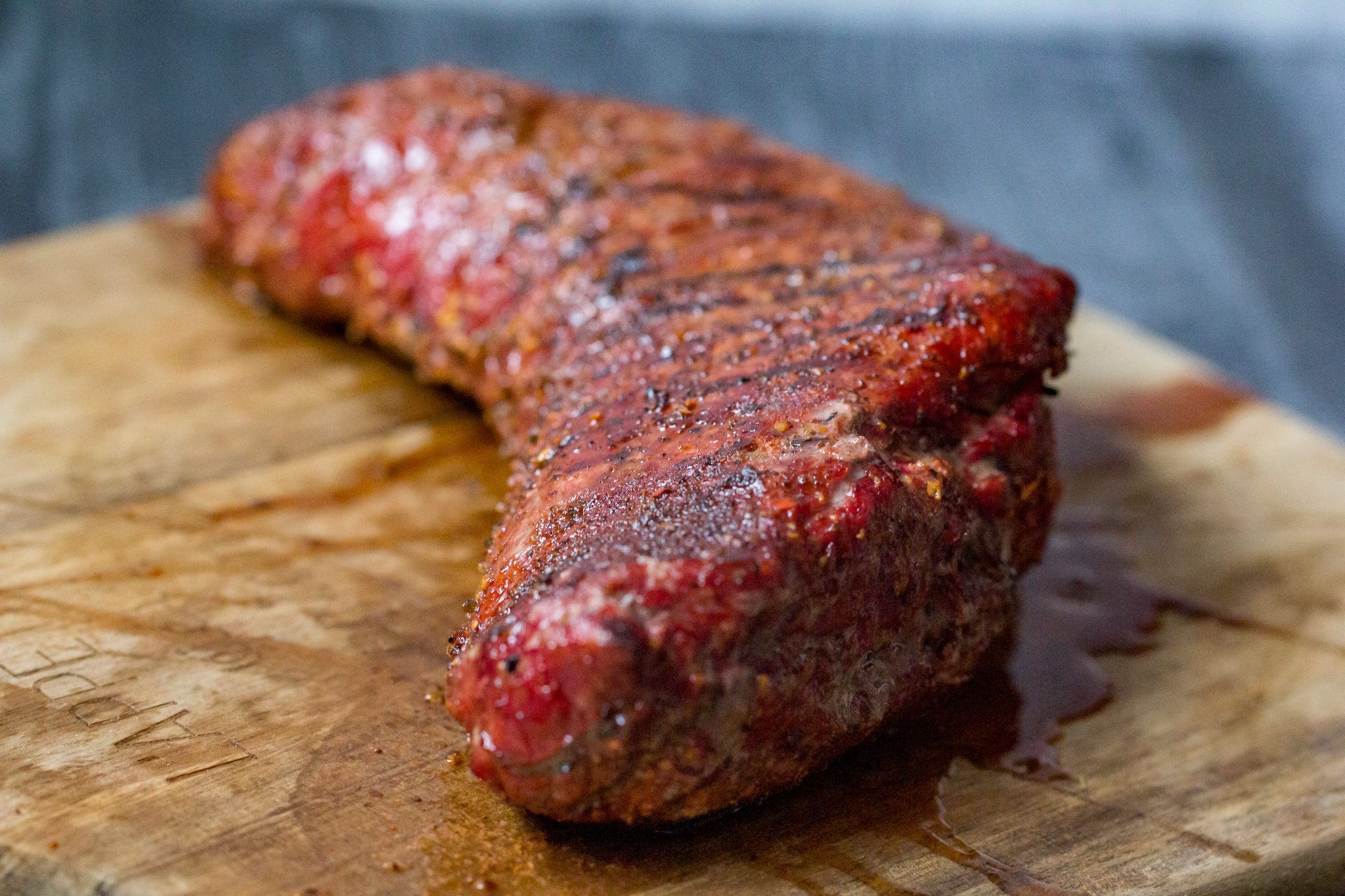
Tri Tip Preparation Basics
Seasoning
When it comes to seasoning your tri tip, you don’t need to complicate things. A good cut of beef stands up on its own and doesn’t need to be buried under a mountain of spices and flavors. You can keep it as simple as a liberal sprinkle of salt and black pepper if you’d like.
However, if you want to experiment, feel free to introduce a blend of spices like garlic powder, onion powder, or paprika for an extra punch. I have had great success with our homemade beef rub too! It contains a little hit of horseradish powder.
To Marinate or Not To Marinate – that is the question
The question of whether to marinate tri tip is one that’s sparked many a debate in the barbecue world. On one side, you have advocates who swear by marinating to tenderize the meat and infuse flavor. On the other, purists argue that a good quality tri tip doesn’t need more than salt, pepper, and fire.
Here’s my take: marinating can be a wonderful tool, especially if you’re dealing with a leaner cut. A simple marinade of olive oil, vinegar or citrus juice, and your chosen spices can work wonders in enhancing flavor. Is it necessary? No. Not if you buy good meat. Can it add amazing flavor? You betcha.
Try my Steak Marinade with this roast sometime and let me know what you think!
In the end, the decision to marinate comes down to personal preference. Experiment with both methods and see which results you prefer. After all, cooking is about finding your own unique style and taste.
Our Original Traeger Tri Tip!
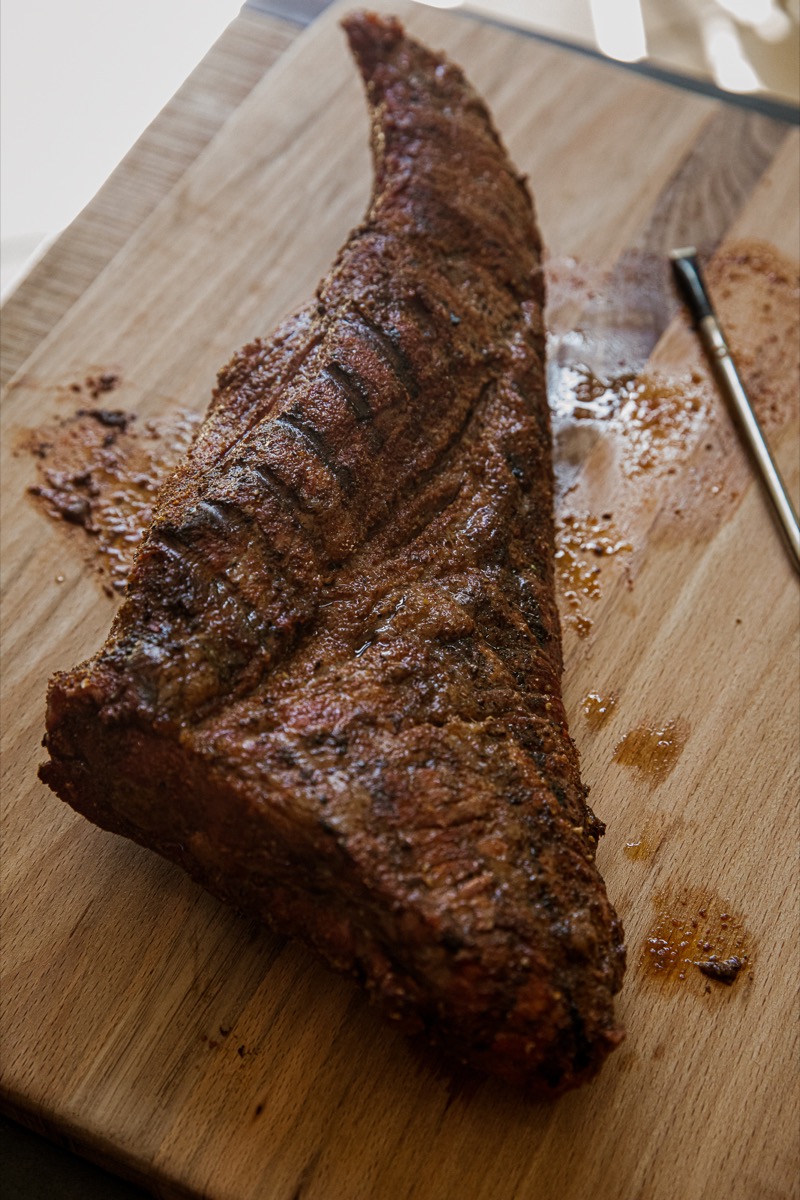
Reverse Searing Method
Let’s tackle reverse searing, a method that flips traditional grilling techniques on its head.
It’s all about starting low and slow, then finishing hot and fast. Sounds counterintuitive? Well, the results speak for themselves. Reverse searing allows the meat to cook more evenly, offering an edge-to-edge consistent doneness, unlike traditional methods where the outer layers are more done than the center.
We use this method for our Smoked Tri Tip recipe, too!
Step-by-step guide to reverse searing tri tip on the grill
Ready to give reverse searing a shot? Here’s how. Start by preheating your grill to a low temperature, about 225°F. Then place your seasoned tri tip on the grill grates, away from direct heat. Close the lid and let it cook slowly until it reaches an internal temperature of around 110-115°F. Use a wireless thermometer like the ThermoWorks Smoke or the Meater for best results.
Now, crank up your grill, gas griddle, or cast iron pan on the stovetop over high heat. Transfer the tri tip to direct heat and sear each side for a few minutes until a nice, crusty bark forms and the internal temperature rises to 125°F – 130°F for medium-rare.
Tips for perfect reverse searing
Patience is the key to a successful reverse sear. Rushing the low and slow phase might result in uneven cooking. Make sure to rest your meat after the initial slow cook and before the final sear. This allows the juices to redistribute within the tri tip.
Keep a close eye during the searing phase, as the high heat can cause flare-ups. Turn your meat frequently to avoid over-charring. And of course, let your meat rest after the final sear. It helps the juices settle and gives you a juicy, tender tri tip.
Get all of my Traeger Recipes here!
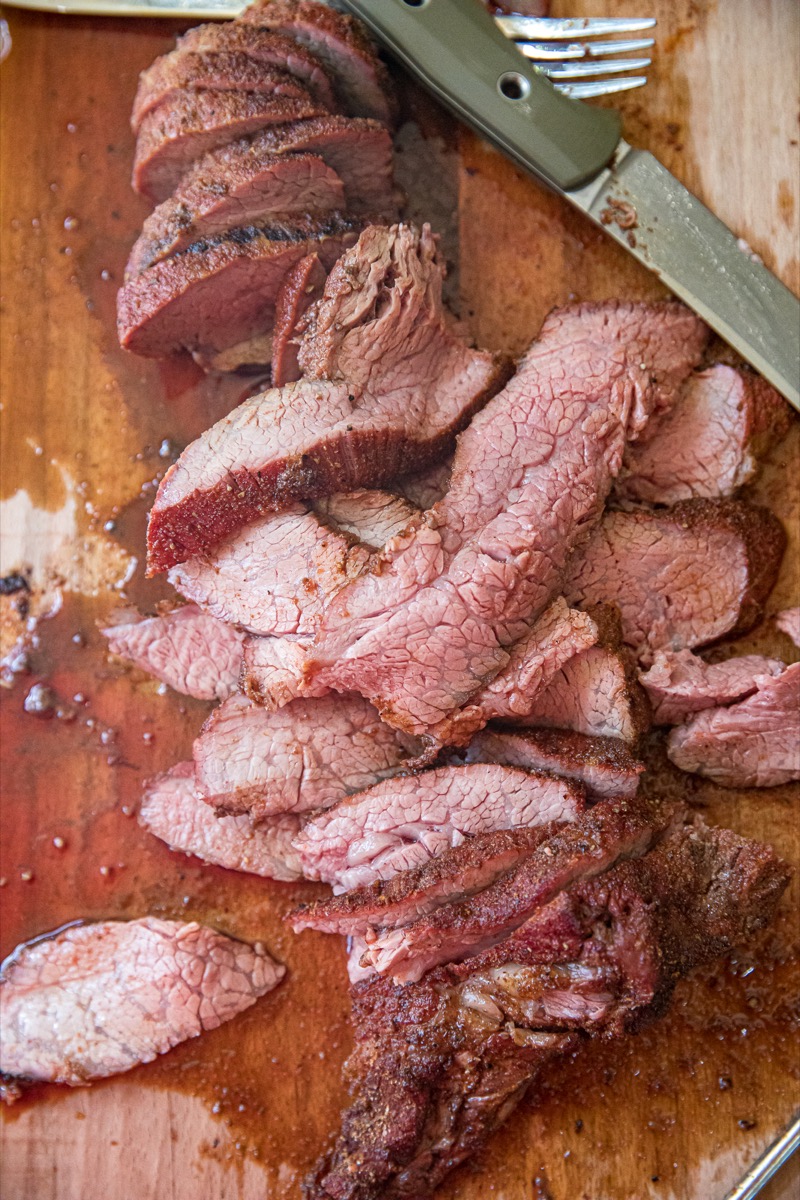
Sous Vide Method
Sous vide, French for “under vacuum”, is a cooking technique that offers unparalleled control over temperature. It involves sealing the food in a bag and cooking it in a water bath at a precise temperature. This technique ensures even cooking, preserves moisture, and enhances the flavor of your tri tip.
How to Sous Vide a Tri Tip
To sous vide your tri tip, start by seasoning your meat and sealing it in a vacuum bag. Set your sous vide machine to the desired temperature. For medium-rare, aim for around 125°F-130°F.
Submerge the sealed bag in the water bath and cook for about 4-6 hours. Once done, remove the bag, pat the tri tip dry, and give it a quick sear on a hot pan or grill for that appealing crust. Just like reverse searing, let it rest before slicing to let all of those liquids redistribute through the meat so it doesn’t end up on your cutting board instead of in your mouth.
Advantages of sous vide for tri tip
Sous vide offers a few distinct advantages. Precision is the first one. With sous vide, you can dial in the exact doneness you prefer.
Another advantage is the juiciness and flavor preservation. By cooking the tri tip in its own juices, you’ll get a flavorful and moist end product. Lastly, sous vide allows for a convenient, hands-off cooking process, giving you the freedom to focus on other elements of your meal while your tri tip cooks to perfection.
Oven Roasting Method
Roasting in the oven is one of the simplest ways to cook a tri tip. It is a great option if your grill is buried in snow or the weather isn’t ideal for outdoor cooking.
Preheat your oven to 425°F. Season your tri tip and place it on a roasting rack set inside a roasting pan. Use a wireless thermometer and roast until the internal temperature reaches 125°F-130°F for medium rare. Make sure to rest the roast for 10-15 minutes before slicing for the best results.
Get 75+ of my favorite Traeger Recipes here!
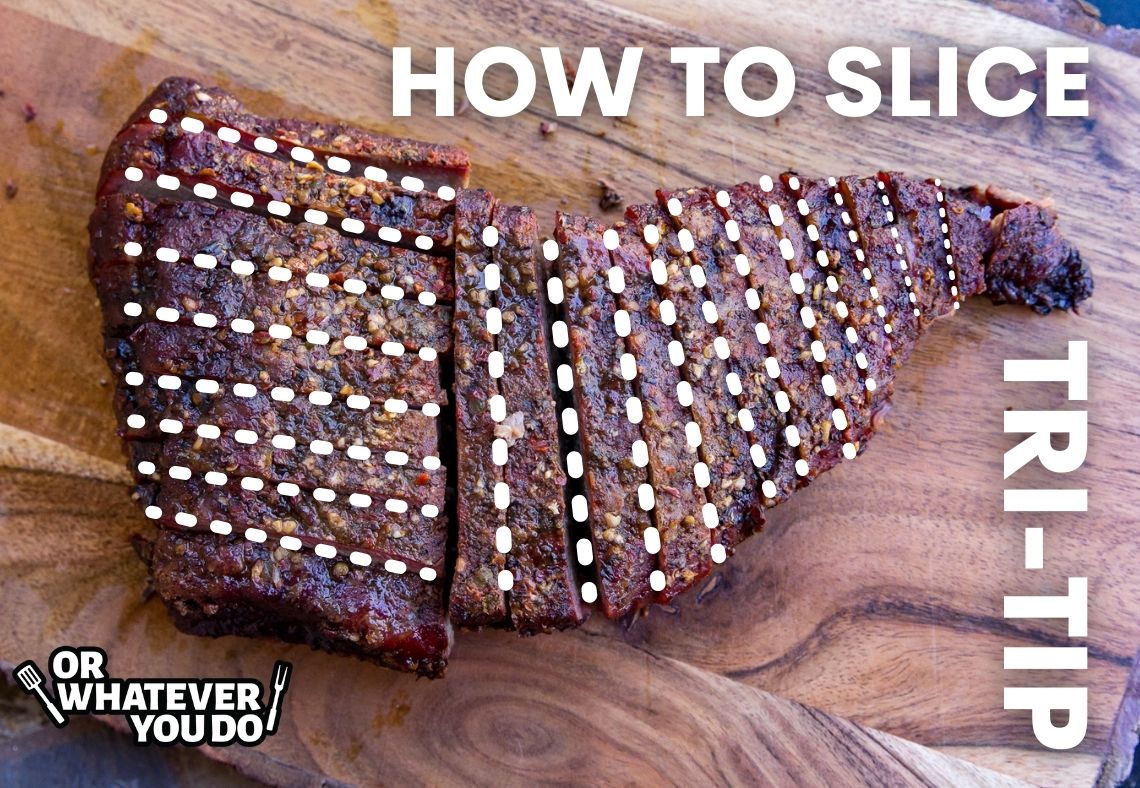
How to properly slice a tri tip?
Here’s the golden rule: always cut against the grain. The grain in a tri tip runs in two directions, which can make slicing a bit tricky. My advice is to slice the tri tip in half at the point where the grains change direction, then cut each piece separately against the grain. This will yield tender, mouthwatering slices, ready for you to enjoy.
Try your tri tip in my Grilled Steak Sandwich!
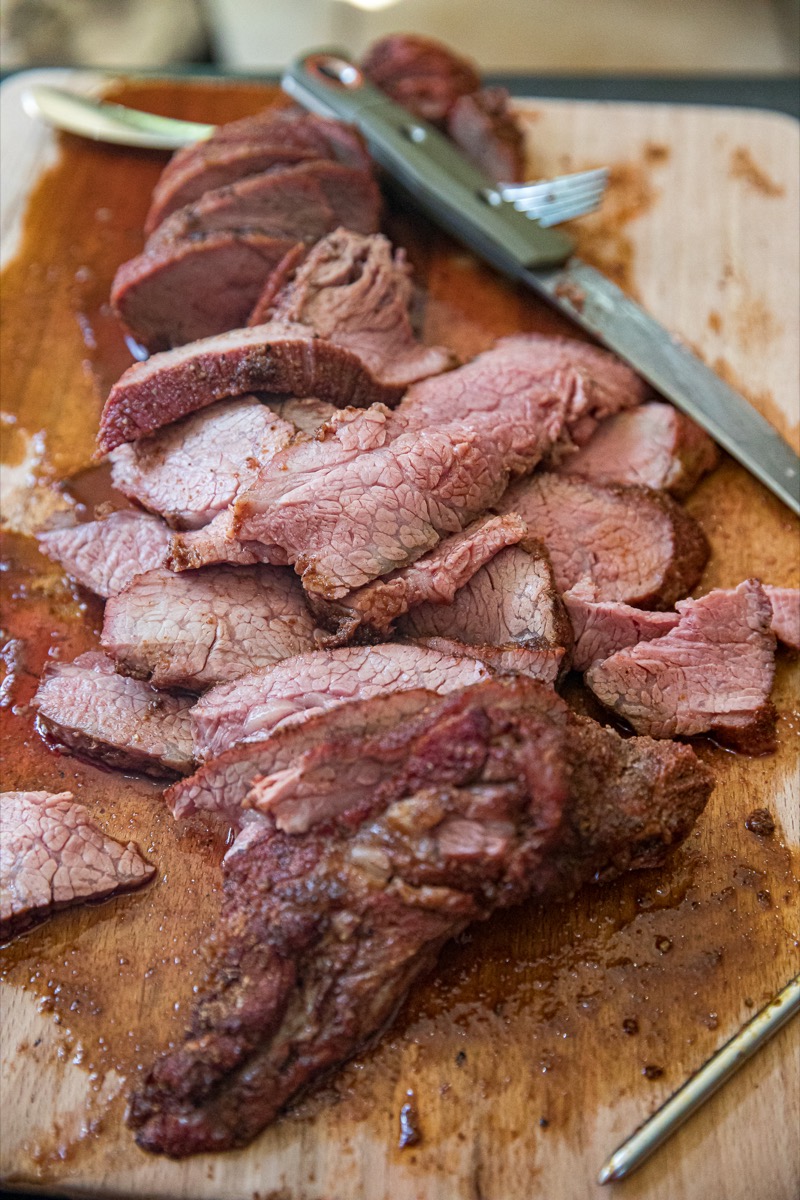
Tri Tip FAQ
Does sous vide cooking make the tri tip too soft or mushy?
Sous vide gets a bad rap sometimes for making meat too soft. But here’s the thing: with the right temperature and time, sous vide cooks your tri tip to your preferred level of doneness while keeping it juicy and flavorful. It’s not about making the meat mushy, but about achieving consistent, precise results that you can replicate every time.
Why is my oven-roasted tri tip coming out too dry?
If your oven-roasted tri tip is hitting the plate more like shoe leather than juicy steak, it’s probably overcooked. That’s why a meat thermometer is your best pal when it comes to roasting. Aim for an internal temperature of 125°F-130°F for medium-rare.
Also, letting the meat rest after roasting is crucial. It allows the juices to redistribute within the meat, ensuring a tender and juicy bite.
How about some Smoked Mac and Cheese?
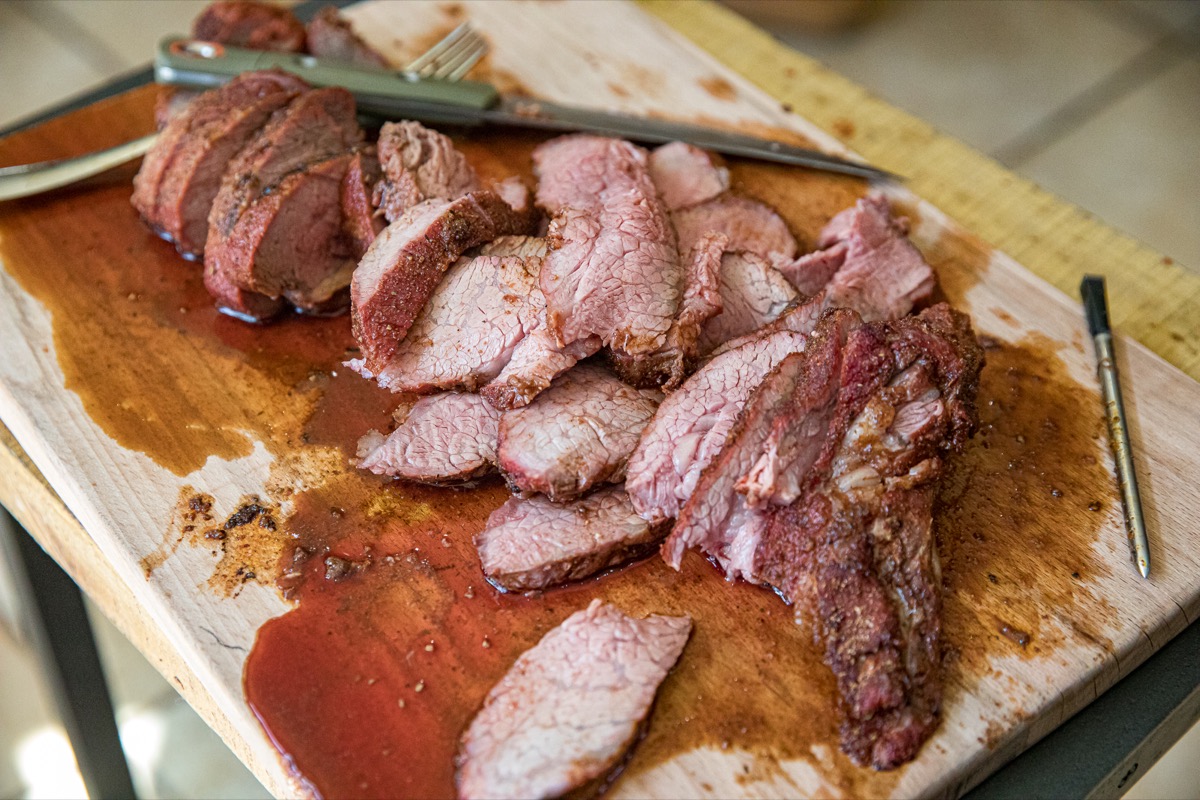
Round out your barbecue with these amazing recipes!
- Elevating a classic comfort food, the smoky depth in these Smoked Baked Beans turns every barbecue into a flavorful feast.
- Brimming with fresh cucumbers, ripe tomatoes, tangy feta cheese, and rich olives, the Greek Salad is a vibrant and healthful side that complements any meal beautifully.
- Marrying tender smoked chicken with creamy Gorgonzola cheese, this Smoked Chicken Gorgonzola Pasta Salad is a savory delight perfect for a light lunch or a hearty side.
- Merging delicate tuna flavors with fresh veggies and perfectly cooked pasta, the Tuna Pasta Salad is a simple, satisfying meal that’s teeming with protein.
- Infusing the smoky-charred notes of grilling with the classic creaminess of Caesar dressing, the Grilled Caesar Pasta Salad is an innovative spin on two cherished dishes.
- By adding a deep, smoky note to the traditional potato salad, the Smoked Baby Potato Salad introduces an extra layer of flavor, transforming it into an instant crowd-pleaser.
- Perfectly roasted on a Traeger grill, this Traeger Corn on the Cob is a succulent, sweet treat offering an irresistible smoky finish.
- Far from somber, the Smoked Funeral Potatoes are the heart of any party, delivering a golden, crispy exterior and a creamy, cheesy interior tinged with a hint of smoke.
- Accentuated with a hint of smoke, these Grilled Cheddar Bay Biscuits bring a touch of savory delight to your meal with their flaky texture and rich cheddar flavor.
- Gently grilled on a pellet grill, the Pellet Grill Zucchini and Yellow Squash retain their fresh flavor, enhanced by a subtle smoky aroma that makes this dish an excellent accompaniment to any barbecue.
- Infusing a creamy dip with rich, smoky salmon, the Smoked Salmon Dip is a decadent appetizer that’s sure to tantalize your tastebuds.
- Charred to perfection, the Perfect Grilled Asparagus provides a tender crunch and smoky note that pairs seamlessly with a variety of main courses.
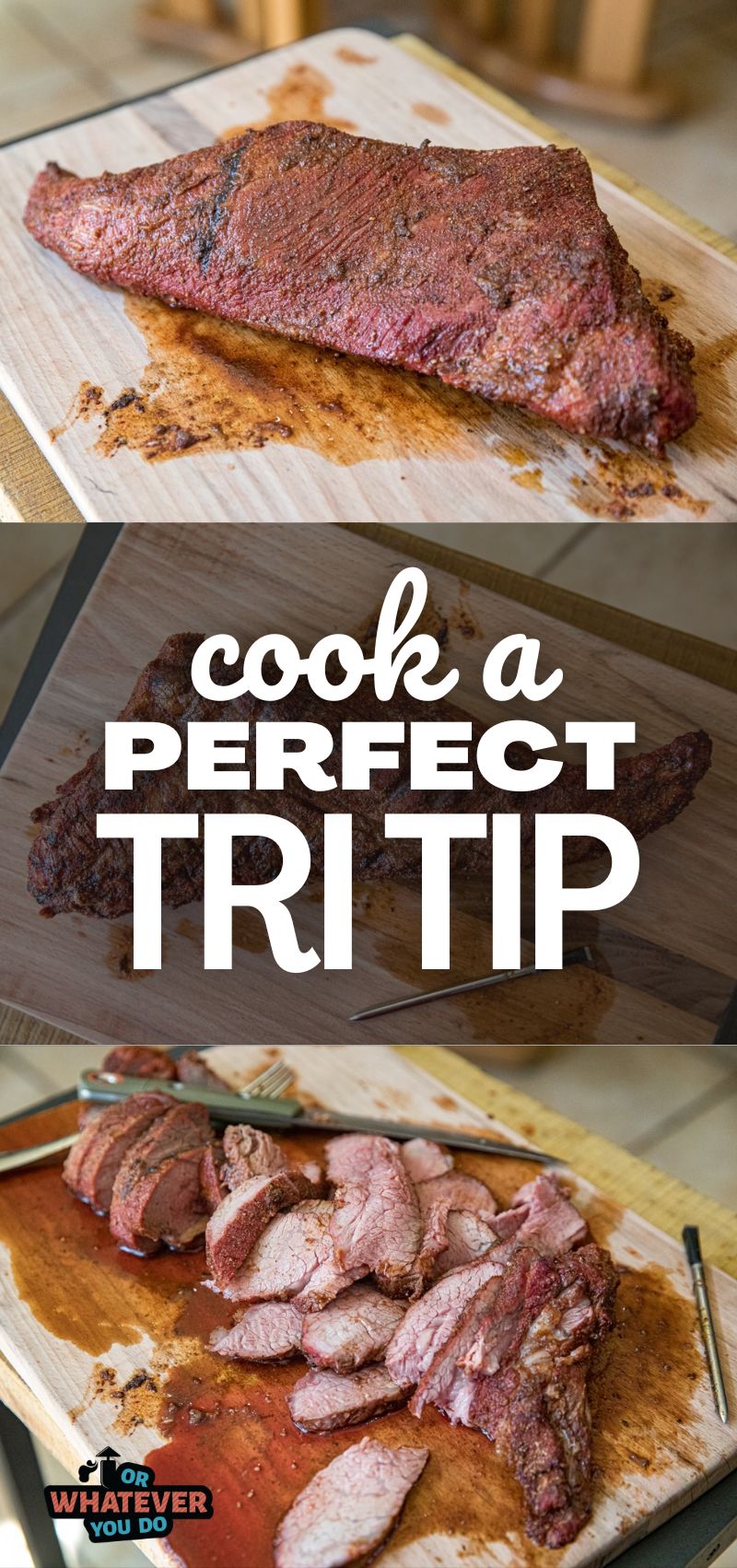
How to Cook a Perfect Tri Tip

This delicious beef roast is gaining popularity and once you try it, you'll see why! I'm going to walk you through cooking the perfect tri tip, no matter HOW you decide to make it!
Ingredients
- 4 pound tri-tip roast (anywhere from 3-6 pounds will work)
- 3 tablespoons seasoning mix
Instructions
- First, you need to choose your adventure as far as the cooking method goes. Are you making your tri tip in the oven, on the grill, or sous vide? Whatever you decide, get it preheating.
- Season your roast. You'll notice I didn't specify with WHAT in the recipe card. That's because you have options here. Whatever option you choose, you should use about 3 tablespoons of it though. This is a big piece of meat and it takes a decent amount of seasoning to properly flavor it.
GRILLING
- Preheat to 250°F. Put your seasoning roast into the pellet grill. Flip after 30 minutes. Cook another 30 minutes.
- Turn the heat up to 350°F and cook until the internal temperature reaches 125°F-130°F.
REVERSE SEAR
- Preheat your smoker to 220°F. Place the meat inside and cook until it reaches 125°F (for medium rare.)
- After it hits 125°F, remove it from the grill and pick how you will do the sear. You can either crank the heat up in your grill to 450°F+, fire up the flat top griddle, or even a cast iron pan on the stovetop.
- Whatever method you use, sear the steak on all sides. Once it is seared, let it rest for 10-15 minutes before slicing.
OVEN
- Preheat your oven to 425°F.
- Put your seasoning roast onto a rack, and place the rack onto a pan.
- Put the whole shebang into the oven with a wireless thermometer and cook until the internal temp is 125°F. Remove, let rest, and the slice.
SOUS VIDE
- Preheat your sous vide machine to 5° under your desired final temp. For us, that's 120°F-125°F.
- Season the roast and place it into a large sous vide bag. Vacuum seal it. Place the bag into the preheated water. Let it cook for 4-6 hours.
- Remove from the water and then remove from the bag. Sear the roast in a blazing hot grill or in a cast iron pan on the stovetop. Let it rest for 5-10 minutes before slicing.
Recommended Products
As an Amazon Associate and member of other affiliate programs, I earn from qualifying purchases.
Nutrition Information:
Yield:
8Serving Size:
1Amount Per Serving: Calories: 481Total Fat: 25gSaturated Fat: 0gTrans Fat: 0gUnsaturated Fat: 0gCholesterol: 188mgSodium: 1830mgCarbohydrates: 1gFiber: 0gSugar: 0gProtein: 59g
Nutrition data provided here is only an estimate.
The post How To Cook Tri Tip appeared first on Or Whatever You Do.


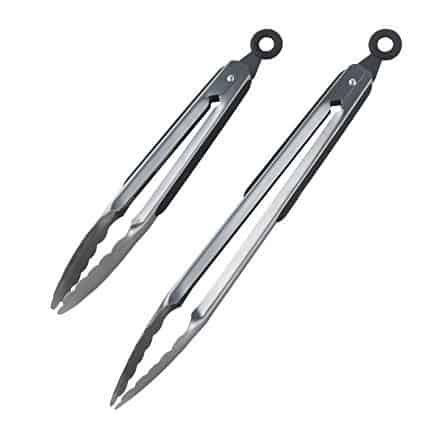
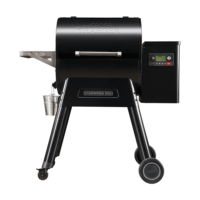
Leave a comment